Rodin: The Thinker |
Already in the first year of working on 'The Gates of Hell', Rodin modeled the central figure of this great composition: 'The Thinker'. 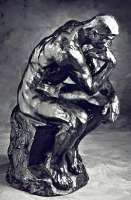 As an independent work it became perhaps the best-known sculpture of all time. As an independent work it became perhaps the best-known sculpture of all time. Seated on the tympanon of 'The Gates of Hell', 'The Thinker' watches the whole scene of the Inferno, brooding in contemplation. His athletic body is twisted in tension from his head down to his curled toes, suggesting a tough intellectual struggle. While the right muscular arm supports the pensive head, the left hand is open, as if ready grasp the reality of his vision and to act. 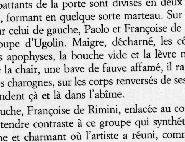 Already in 1885, Mirbeau noted that both the title and the subject of 'The Thinker' reminded of Michelangelo's 'Il Penserioso' on the tomb of Guiliano di Medici. Already in 1885, Mirbeau noted that both the title and the subject of 'The Thinker' reminded of Michelangelo's 'Il Penserioso' on the tomb of Guiliano di Medici. [Octave Mirbeau, 'Auguste Rodin', in La France, Paris, 18 Febr. 1885 For complete text, click here: Page 1+2 Page 3+4 ] Originally, 'The Thinker' - exhibited in Copenhagen in 1888 as 'The Poet' - was to represent Dante Alighieri, the author of the Divina Commedia, who - according to a popular anecdote - also used to sit and think on a rock in Florence called Sasso di Dante, watching the Baptistry. As a portrait of Dante, 'The Thinker' symbolized the intellectual power that created the dramatic world depicted in 'The Gates': 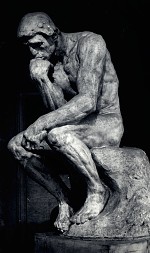 "In front of this Porte [Rodin explained to a journalist at the turn of the century], but on a rock, Dante was to be seated in profound meditation, conceiving the plan of his poem. Behind him, there was Ugolino, Francesca, Paolo, all the characters of the Divine Comedy. But something came of this idea. Gaunt, ascetic in his straight robe, my Dante, seperated from the ensemble, would have had no meaning. Still inspired by my original idea, I conceived of another Thinker, a naked man crouched on a rock against which his feet are contracted. Fist pressed against his teeth, he sits lost in contemplation. His fertile thoughts slowly unfalled in his imagination. He is not a dreamer; he is a creator." "In front of this Porte [Rodin explained to a journalist at the turn of the century], but on a rock, Dante was to be seated in profound meditation, conceiving the plan of his poem. Behind him, there was Ugolino, Francesca, Paolo, all the characters of the Divine Comedy. But something came of this idea. Gaunt, ascetic in his straight robe, my Dante, seperated from the ensemble, would have had no meaning. Still inspired by my original idea, I conceived of another Thinker, a naked man crouched on a rock against which his feet are contracted. Fist pressed against his teeth, he sits lost in contemplation. His fertile thoughts slowly unfalled in his imagination. He is not a dreamer; he is a creator." [Marcelle Adam, Le Penseur, in: Gil Blas, Paris, 7 July 1904, quoted by Grunfeld, chapter 8, p. 191] Interpreted this way, 'The Thinker' was detached from his personal connection with Dante and now is seen to represent the power of thought and mental creativity more generally. 'The Thinker' not only confirms Dante´s high reputation as the embodiment of Plato's ideal of the artist-philosopher: on a more abstract level, Rodin's work associates the creative qualities of artistic genius with the ability to understand and judge society from a higher standpoint. Because of his central place high above the turmoil of the sinners, Elsen even draws a parallel to the figure of Christ in the Judgement Seat.Another identification of the artist with Christ can be found in 'Christ and Mary Magdalene'; in 'The Hand of God', finally, the creative power of the Deity is directly associated with that of the sculptor. The elevated position of 'The Thinker' also caused Rodin to enlarge the shoulders and arms, so that the proportions seem balanced when looking up to the figure from the ground. Later, when 'The Thinker' was enlarged and exhibited as a separate work, its lower placement led to an irritating impression of top-heaviness. Still during Rodin's life-time, several critics speculated on the question, what 'The Thinker' was actually thinking about. With the growing popularity of the socialist movement, 'The Thinker' was sometimes interpreted as a working class hero, rising from the fetters of the material world to the heights of class consciousness: Democracy has had its heroes and its statues. But these heroes were often no more than bourgeois. (...) The Thinker of Mr Rodin is, on the contrary, the anonymous unknown worker, the first to come from among the proletariat, whose native homeliness the artist has exaggerated, again according to the exigencies and manner of his art (...) The proletariat will be flattered ... to see itself endowed with thought - the proletariat that is so often accused of having only blindness and instincts. 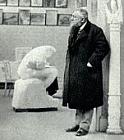 Morphologically spoken, Rodin´s 'Thinker' is the successor of the torso of the 'Seated Ugolino', which Rodin created during his years in Belgium. Around 1876, Rodin created a further study of a seated man, which can be seen as a another predecessor to 'The Thinker' (plaster, Nelson-Atkins Museum). Finally, the giants at the base of the 'Vase of the Titans' Morphologically spoken, Rodin´s 'Thinker' is the successor of the torso of the 'Seated Ugolino', which Rodin created during his years in Belgium. Around 1876, Rodin created a further study of a seated man, which can be seen as a another predecessor to 'The Thinker' (plaster, Nelson-Atkins Museum). Finally, the giants at the base of the 'Vase of the Titans' 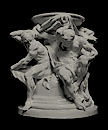 deal with the same complex task of endowing seated heroes with an expression of activity and strength. In 1901, Rodin recurred to 'The Thinker' while creating 'The American Athlete'. deal with the same complex task of endowing seated heroes with an expression of activity and strength. In 1901, Rodin recurred to 'The Thinker' while creating 'The American Athlete'. The first exhibited version of 'The Thinker' – 1888 in Copenhagen – in plaster was 71.5 cm high. Only in 1902, when Rodin began to have some of his most popular sculptures enlarged by his helper Henri LeBossé, a monumental version of 'The Thinker' was created as well, ca. 1.84 m high. The enlargement was completed by the end of 1903 and shown in the Spring Salon in Paris 1904. In the Revue blue of 17 Dec. 1904, Gustave Geffroy commented:"If he were to stand up and walk, the ground under his feet would tremor and scores of soldiers would part for him." The first colossal bronze cast was produced by the young, ambitious founder Hébrard, who promised Rodin to deliver a cast made after the prestigeous lost wax method, for the price of a sand cast. This first cast was shipped to the Louisiana World Exhibition and shown to the public, till Rodin began to doubt the quality of the patina and sent a plaster cast to Mississippi to replace the metal sculpture, which was eventually bought by Mr Walker. In Paris, Gabriel Mourey, publisher of the New magazine Les Arts de la Vie, took the initiative to organize a public subscription with the aim to present a monumental bronze cast "to the people of Paris", to be placed in front of the Panthéon. As a maquette, a bronze coloured plaster was installed there; on 16 January 1905, this provisory sculpture was destroyed by a fanatic, called Poitron, who claimed the thinking poet was mocking at him. In April 1906, the final bronze version was installed and remained in front of the Panthéon for 16 years. In 1922, the statue with its pedestal was transported to the garden of the recently opened Musée Rodin, allegedly because it would be an obstacle during public ceremonies. By now, there are over 20 examples of the colossal bronze cast, placed in cities all over the world. One of the casts, manufactured by the Alexis Rudier Foundry, is placed next to the tomb of Rodin and his wife Rose Beuret in Meudon. For a detailed overview of all monumental plaster and bronze examples, see http://www.penseur.org/. BIBLIOGRAPHY (supplied by The National Gallery of Art, Washington): |
MISSION STATEMENT ... To celebrate where it's deserved! ... To take the Michael out of institutions and individuals where it's deserved! ... Recently I had occasion to prepare my gravestone epitaph: GENE... Educator, Novelist, Humanitarian and Humorist - TO KNOW HIM WAS TO LOVE HIM - Rest in Peace ....... But while I am still walking the earth do not hesitate to contact me at: bobbyslingshot8@gmail.com
Wednesday, 11 April 2012
Rodin: The Thinker
Subscribe to:
Post Comments (Atom)
No comments:
Post a Comment